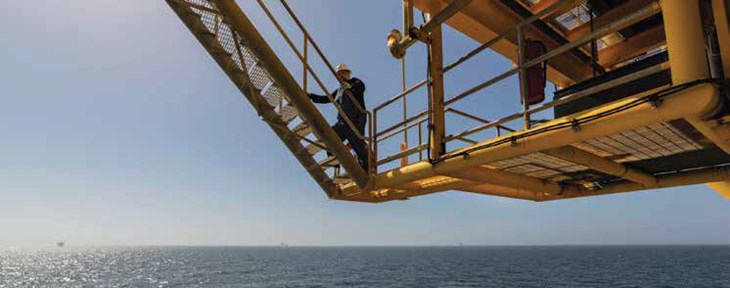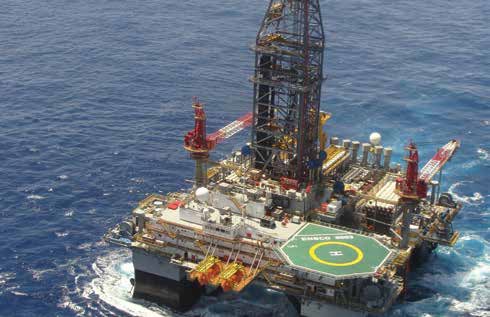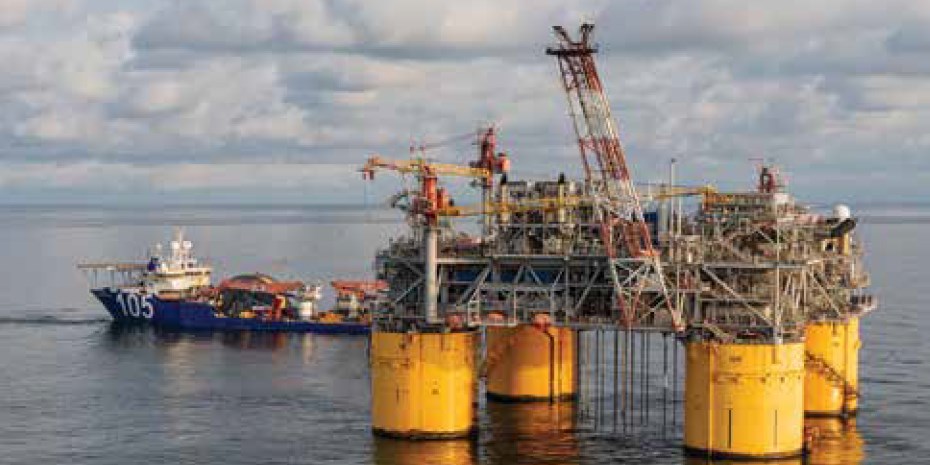Valve World Americas had the opportunity to speak with Gomes about what subsea engineering entails, the most rewarding parts of the job, its challenges, and what industry developments he foresees.
By Sara Mathov and Sarah Bradley
Becoming a Subsea Engineer
Joe Gomes Junior studied engineering at the Massachusetts Maritime Academy where he graduated with a Bachelor of Science, and a minor in facilities engineering and energy management. After working as an engineer intern, he began his career as a regimental training and retention officer at the Academy, before moving on to maintenance intern. From there, he was hired at Talos Energy, where he is currently employed. Talos is a leader in offshore energy exploration and production that combines technical experience in geology, geophysics and engineering with innovative resource evaluation techniques and seismic imaging expertise to discover new resources. Talos is one of the largest independent companies in the Gulf of Mexico, with operations across a range of deepwater and shallow water assets in both the United States and Mexico.
Rising through the ranks, he progressed from engineer trainee to floor hand, to Ensco plc, to an offshore operations engineer. As an offshore operations engineer, Gomes had the opportunity to work on a rotation and partake in the planning and execution of the HP-I Dry Dock. “Once the Dry Dock project had been completed, I began my current position as a Subsea Engineer,” explained Gomes. “I started in the drilling contractor side and then jumped over to the operator side.”
Although still in the realm of engineering, subsea applications have several different focuses that require specific training and skill sets. “There are a lot more standards and regulation with subsea applications,” said Gomes. “As the locations we are working on are rather inaccessible, a large amount of the day-to-day operations are performed remotely. We use remotely operated vehicles (ROV) and the operators have to have excellent troubleshooting skills.” As maintenance on subsea tends to be more expensive than maintaining equipment above water, cost tracking adds another factor to the work. “When you install equipment, you are basically designing it for field life,” said Gomes. “There are a few different valves and components on the subsea infrastructure that you can change out, but for the most part once you install it subsea, it stays there for the life of the field.”
Subsea applications cannot be maintained as regularly as on-land operations and therefore face risks of corrosion. A subsea engineer’s primary job is to troubleshoot or replace different valves and chokes underwater, or to set up new wells.

Day in the Life
On a typical day, Gomes’ primary objective is to maintain the subsea equipment that has been installed. Based out of a Phoenix field in the Gulf of Mexico, there are multiple ongoing projects that require constant attention. Daily tasks can range from running vessels to working remotely. “I could go from running a boat shoreside, operating a ROV vessel or installation vessel, to providing office support,” said Gomes. “In addition to the day-today projects, I am also responsible for assessing the subsea infrastructure and determining if additional systems, such as well developments, are required.”

Highlights and Challenges
Gomes believes that the troubleshooting process for detecting and solving issues that arise with applications is both the most rewarding and most challenging aspect of his job. As a large precent of the work is done remotely, trying to figure out what is wrong with the equipment can be quite challenging. “There are a lot of unknowns, so you are really looking at data and making assumptions and decisions. It is a very interesting experience when you cannot physically see the valve, or application, and you must determine the most effective and efficient way to fix it,” said Gomes. Providing office support is necessary to assist those working offshore to mitigate the risk of accidents and incidents.
“It is always rewarding when you are able to get a ROV out to a site to assess how effective one’s fixes have been, especially if the estimates that have been made are correct,” continued Gomes. “On the other hand, not being able to see the issue can add a different, more challenging, element to the work.” The inability to physically see what is causing an issue makes it much more difficult to ensure that the issue is fully resolved rather than temporally fixed.
Another common challenge that Gomes faces is avoiding differential pressures when opening and closing valves. “It is important to try to equalize as much as possible,” said Gomes. Corrosion on the valve stem and erosion on the body are other primary points of concern for subsea valves. “Protecting valve stems from corrosion is a high priority and we generally take a number of steps to try and avoid allowing them to fail. For example, an inverted bucket is a simple design that acts as a unique leverage system that multiplies the force provided by the steam trapped in the bucket to open the valve against pressure; it is an application that allows for manually operated valve. Once it is installed, the valve can be opened or closed with an ROV.
Gomes recalls a time when he and his team designed a tool to drill out the bolts, remove the bucket, and replace it. “The process included taping four bolts, moving the bucket, and installing a new one in place,” he said. “It sounds simple, but it is actually quite difficult to do.” As the applications in subsea projects are so high profile, if an application needs to be fixed it is typically replaced; chokes or retrievable chokes can sometimes be replaced.

How Valves are Used in Subsea
Valves or subsea chokes, are frequently used in subsea applications to regulate the flow and performance of each well. For example, gate valves are commonly used to manipulate flow, or for isolation. “Subsea chokes are installed on trees, and they regulate the flow and how the wells are performing,” explained Gomes. “Each well has its own tree specifically designed to meet its particular needs.” The largest difference between valves used in subsea applications and those used on land, is the types of materials that are used. “Material wise, they are held to a different standard,” said Gomes. “It is a little bit more stringent.”
Recommendations for Newcomers
For those just getting started in the industry, he said having experience working offshore is important to understand the work. When it comes to hands-on experience, it makes a huge difference, said Gomes. “It is almost essential, almost like a prerequisite,” said Gomes. “Get as much offshore experience as possible, listen to the people out there, as they have valuable information to impart.”
Looking Ahead
Enhancing digital practices and remotely operated technology is extremely important for the industry. “A movement towards more digitization is vital,” relayed Gomes. “It is basically the only way an operator can use this equipment, unless there are subsea controls present. When ROV’s are in place, they live in charging stations and are deployed when needed. This basically eliminates the need for big vessels to come out with them installed on it, which helps reduce the vessel costs.”
The future of the industry also depends on the need for oil and natural gas, said Gomes. “Right now, we are at a stage of ‘wait and see’,” expressed Gomes. “Long term, it is a commodity and I think that the demand will still be there in the future.”
Types of Materials in Subsea Applications
Subsea applications require special materials to help avoid corrosion. Corrosion and erosion can cost billions of dollars annually, due to unplanned plant shutdowns, lost production, and high maintenance repair costs. Material selection therefore must meet demands to resist corrosion caused by production fluids, and seawater.1
The typical materials used for subsea applications and valve trees are: carbon or low alloy steel, carbon or low alloy steel with alloy 625 weld overlay, 22 Cr Duplex stainless steel, 25 Cr Super Duplex stainless steel, Martensitic stainless steel with alloy 625 trims, and Nickel alloys. The material selection is based on the application specific requirements and end users must consider several factors prior to selection. Some of the factors include: design life, cost, inspection and maintenance, safety, environmental philosophy, failure and risk, and the specific project specifications.2
Types of Valves in Subsea Applications
There are hundreds of types of valves used for subsea applications. Some of the most commonly used types include:
• Subsea ball valves – usually operated by mechanical or hydraulic operators. The ball valve allows side entry and typically is lower cost.
• Subsea gate valves – often used for isolation applications, such as harsh environments where maintenance is not possible. They typically last 25 years.
• Subsea small bore valves – used for chemical isolation. They can be used for both tree and manifold applications.
• Subsea choke – for use in production, liquids and gas injections. Chokes use multiple orifice valve technology to control flow.
• Subsea chemical injection metering valves, which are remotely operating, ROV-retrievable and self-regulating.
• Subsea check valves, which show the direction of flow and have a low pressure nozzle for a fast response time.3
A typical field layout would include a wellhead and trees, spools and jumpers, equipment, flowlines and risers, valves, and bolting and gaskets.2
REFERENCES
1. “Material selection guidelines to help prevent corrosion in oil and gas production.” 2017. Elsevier’s R&D Solutions for Oil and Gas, https://www.elsevier.com/__data/assets/pdf_file/0014/532301/OG-EP-KNWP-Material-Selection-to-Prevent-Corrosion_Final-Web.pdf
2. “Materials for Subsea Applications.” 2012. Subsea7, https://www.icorr.org/wp-content/uploads/2020/06/2012-08-22-C-Ikeagu-of-Subsea-7_-Material-Selection-for-Subsea-Applications.pdf
3. “Subsea Valve Portfolio.” 2019. Cameron Subsea Valve Center of Excellence, https://www.slb.com/-/media/files/vl/brochure/subsea-valves-br.ashx
Images courtesy of Talos Energy.


